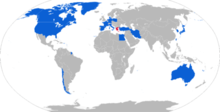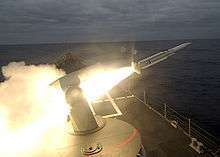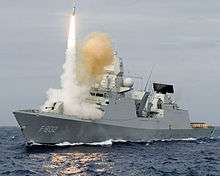RIM-66 Standard
The RIM-66 Standard MR (SM-1MR/SM-2MR) is a medium-range surface-to-air missile (SAM), with a secondary role as anti-ship missile, originally developed for the United States Navy (USN). A member of the Standard Missile family of weapons, the SM-1 was developed as a replacement for the RIM-2 Terrier and RIM-24 Tartar that were deployed in the 1950s on a variety of USN ships. The RIM-67 Standard (SM-1ER/SM-2ER) is an extended range version of this missile with a solid rocket booster stage.
| RIM-66 Standard MR | |
|---|---|
A RIM-66 Standard MR on a Mk-26 launcher | |
| Type | Medium-range surface-to-air missile |
| Place of origin | United States |
| Service history | |
| In service | 1967 (RIM-66A SM-1MR Block I) 1979 (RIM-66C SM-2MR)[1] |
| Used by | United States Navy, Japanese Maritime Self-Defense Force, Royal Australian Navy, Turkish Navy, Royal Netherlands Navy, German Navy, Royal Canadian Navy, Chilean Navy and Others |
| Production history | |
| Manufacturer | Raytheon and others |
| Produced | 1967 Onwards |
| No. built | Over 5,000 |
| Specifications | |
| Mass | SM-2 – 1,558 lb (707 kg) |
| Length | 15 ft 6 in (4.72 m) |
| Diameter | 13.5 in (340 mm) |
| Warhead | blast fragmentation warhead |
Detonation mechanism | radar and contact fuze |
| Engine | dual thrust, solid-fuel rocket |
| Wingspan | 3 ft 6 in (1.07 m) |
Operational range | 40 to 90 nmi (74 to 167 km) |
| Flight ceiling | > 24,400 m (80,100 ft) |
| Maximum speed | Mach 3.5 |
Guidance system | SM-2MR Block IIIA Command and Inertial midcourse guidance with monopulse semi-active radar homing in the terminal phase of the interception. SM-2MR Block IIIB missiles have dual infrared homing/semi-active terminal homing. SM-1MR Block VI missiles have monopulse semi-active radar homing without command and inertial mid-course guidance.[3] |
Launch platform | Surface Ship |
Description
The Standard missile program was started in 1963 to produce a family of missiles to replace existing guided missiles used by the Terrier, Talos, and Tartar guided missile launch systems. The intention was to produce a new generation of guided missiles that could be retrofit to existing guided missile systems.[4]
Standard Missile 1
The RIM-66A is the medium ranged version of the Standard missile and was initially developed as a replacement for the earlier RIM-24C as part of the Mk74 "Tartar" Guided Missile Fire Control System. It used the same fuselage as the earlier Tartar missile, for easier use with existing launchers and magazines for that system. The RIM-66A/B while looking like the earlier RIM-24C on the exterior is a different missile internally with redesigned electronics and a more reliable homing system and fuse that make it more capable than its predecessor. The RIM-66A/B Standard MR, (SM-1MR Block I to V) was used during the Vietnam War. The only remaining version of the Standard missile 1 in service is the RIM-66E (SM-1MR Block VI). While no longer in service with the USN, the RIM-66E is still in service with many navies globally and is expected to remain in service until 2020.
Standard Missile 2
The RIM-66C/D Standard MR (SM-2MR Block I) was developed in the 1970s and was a key part of the Aegis combat system and New Threat Upgrade (NTU). The SM-2MR introduced inertial and command mid-course guidance. The missile's autopilot is programmed to fly the most efficient path to the target and can receive course corrections from the ground. Target illumination for semi-active homing is needed only for a few seconds in the terminal phase of the interception. This capability enables the Aegis combat system and New Threat Upgrade equipped vessels to time share illumination radars, greatly increasing the number of targets that can be engaged in quick succession.
The SM-1 and SM-2 were continuously upgraded through Blocks.
_launches_a_Standard_Missile-2_while_conducting_torpedo_evasion_maneuvers_during_Multi-Sail_2009.jpg)
In the middle 1980s, the SM-2MR was deployed via Mk 41 Vertical Launch System (VLS) aboard USS Bunker Hill, the first U.S. Navy ship to deploy a vertical launcher. VLS has, since 2003, been the only launcher used for the Standard missile in the U.S. Navy aboard Ticonderoga-class cruisers and Arleigh Burke-class destroyers. They are now most commonly launched from the Mk 41 VLS, which is a modular design concept with different versions that vary in size and weight. There are three lengths for this VLS: 209 in (530 cm) for the self-defense version, 266 in (680 cm) for the tactical version, and 303 in (770 cm) for the strike version. The empty weight for an 8-cell module is 26,800 lb (12,200 kg) for the self-defense version, 29,800 lb (13,500 kg) for the tactical version, and 32,000 lb (15,000 kg) for the strike version.
The Standard can also be used against ships, either at line-of-sight range using its semi-active homing mode, or over the horizon using inertial guidance and terminal infrared homing.[5]
The SM-2 has conducted more than 2,700 successful live firings. In June 2017, Raytheon announced it was restarting the SM-2 production line to fulfill purchases made by the Netherlands, Japan, Australia, and South Korea. Production had stopped in 2013 from lack of international orders. New deliveries of SM-2 Block IIIA and IIIB missiles are scheduled to begin in 2020. The United States Navy is committed to keeping the Standard Missile 2 medium-range viable until 2035.[6]
Contractors
Standard missiles were constructed by General Dynamics Pomona Division until 1992, when it became part of the Hughes Missile Systems Company. Hughes formed a joint venture with Raytheon called Standard Missile Company (SMCo). Hughes Missile Systems was eventually sold to Raytheon making it the sole contractor.[7]
Operational history
The Standard missile one became operational in 1968. The missile was utilized by ships equipped with the Tartar Guided Missile Fire Control System. The missile saw its first combat use in the early 1970s in the Vietnam war.
The Standard Missile Two became operational in the late 1970s and was deployed operationally with the Aegis Combat System in 1983. Both Standard one and two were used against both surface and air targets during Operation Praying Mantis. On July 3, 1988, USS Vincennes mistakenly shot down Iran Air Flight 655, an Airbus A300B2, using two SM-2MR missiles from her forward launcher.[8] In 1988 the Iranian Kaman-class missile boat Joshan was disabled by RIM-66 Standard missiles during Operation Praying Mantis.[9]
On 9 October 2016, the Arleigh Burke-class destroyer USS Mason fired two SM-2 (RIM-66 variant) Standard missiles, as well as an Evolved Sea Sparrow Missile, at incoming Houthi anti-ship missiles off the coast of Yemen. It is unknown if the SM-2 Standards were responsible for intercepting the cruise missiles.[10]
On 1 April 2020, a Turkish Navy G-class frigate fired at least a SM-1MR Block VIA RIM-66E-05 missile supposedly against an UAV operated in support of the Libyan National Army. The missile missed and landed near al-Ajaylat, just southwest of Sabratha.[11]
Deployment history
The Standard missile is designated by blocks depending upon their technological package.
SM-1 Medium Range Block I/II/III/IV, RIM-66A
The First Standard missiles entered service in the USN in 1967. Blocks I, II, and III were preliminary versions. Block IV was the production version. This missile was a replacement for the earlier RIM-24C Tartar missile.
SM-1 Medium Range Block V, RIM-66B
The RIM-66B introduced changes that resulted in higher reliability. A new faster reacting autopilot, a more powerful dual thrust rocket motor, and a new warhead were added. Many RIM-66A missiles were re-manufactured into RIM-66B.
SM-1 Medium Range Blocks VI/VIA/VIB, RIM-66E
The RIM-66E was the last version of the standard missile one medium-range. This version entered service in 1983[4] with the United States Navy and export customers. The RIM-66E was used by all remaining Tartar vessels that were not modified to use the New Threat Upgrade and Oliver Hazard Perry-class frigates which controlled it with the Mk92 fire control system. Production of this missile ended in 1987. The missile was retired from USN service in 2003; however there are a large number of this model in service abroad and it is expected to remain viable until 2020.[12]
SM-2 Medium Range Block I, RIM-66C/D
The RIM-66C was the first version of the Standard missile two. The missile became operational in 1978 with the Aegis combat system fitted to the Ticonderoga-class cruiser. The RIM-66D was the SM-2 medium-range block I version for the New Threat Upgrade. The SM-2 incorporates a new autopilot giving it inertial guidance in all phases of flight except for the terminal intercept where semi-active radar homing is still used. This version is no longer in service; remaining missiles have either been remanufactured into later models or have been put in storage.
SM-2 Medium Range Block II, RIM-66G/H/J
The Block II missile was introduced in 1983 with a new rocket motor for longer range and a new warhead. The RIM-66G is for the Aegis combat system and the Mk26 missile launcher. The RIM-66H is for Aegis and the Mk41 vertical launcher. The RIM-66J is the version for the New Threat Upgrade. Block II missiles are no longer manufactured, and have been withdrawn from service. The remainder have either been put in storage, scrapped for spare parts, or remanufactured into later models.
SM-2 Medium Range Block III/IIIA/IIIB, RIM-66K/L/M
The RIM-66M is the version of the Standard missile two medium-range (SM-2MR) currently in service with the USN aboard Ticonderoga-class cruisers and Arleigh Burke-class destroyers. The missile is specifically designed for the Aegis Combat System and the Mk41 Vertical launch system. The Block III missiles differ from earlier blocks by the addition of the MK 45 MOD 9 target detecting device, for improved performance against low altitude targets. The Block IIIB missile additionally has a dual semi-active/infrared seeker for terminal homing. The dual seeker is intended for use in high-ECM environments, against targets over the horizon or with a small radar cross section.[12] The seeker was originally developed for the canceled AIM-7R Sparrow air-to-air missile. All USN Block III and IIIA missiles are to be upgraded to Block IIIB. Block IIIA missiles are operated by the Japanese Maritime Self-Defense Force on its Kongō-class and Atago-class Aegis destroyers. Aegis equipped vessels in the Spanish and South Korean navies use it as well. The Dutch and German Navies have added it to the Anti-Air Warfare system, which uses the Thales Group Active Phased Array Radar S-1850M and Smart-L radar. South Korean KDX-II destroyers use the block IIIA with a New Threat Upgrade compatible guided missile fire control system. Block III variants for Aegis and arm launchers are designated RIM-66L. Block III missiles for New Threat Upgrade systems are designated RIM-66K. Block IIIB missiles were not produced for the New Threat Upgrade. Blocks IIIA and IIIB are the current production versions. The Thales Nederland STIR 1.8 and 2.4 fire control systems are also supported.[3]
SM-2 Medium Range Block IIIC Active
The Naval Sea Systems Command has announced its intentions to develop an active terminal homing version of the SM-2 MR missile. This will incorporate the active homing seeker of the SM-6 ERAM into the existing SM-2 airframe. The Raytheon Company will be awarded contracts for the STANDARD Missile-2 Block IIIC EMD and LRIP requirements on a sole source basis. [13]
Deployment
_being_assembled_.jpg)
In the US Navy, RIM-66 Standard was deployed on ships of the following classes, replacing RIM-24 Tartar in some cases:
- Charles F. Adams-class destroyer (Mk74 Missile Fire Control)
- Albany-class cruiser (Mk74 Missile Fire Control)
- Oliver Hazard Perry-class frigate (Mk 92 Missile Fire Control)
- Kidd-class destroyer (Mk74 Missile Fire Control SM-1/later New Threat Upgrade for SM-2)
- California-class cruiser (Mk74 Missile Fire Control SM-1/later New Threat Upgrade for SM-2)
- Virginia-class cruiser (Mk74 Missile Fire Control SM-1/later New Threat Upgrade for SM-2)
- Ticonderoga-class cruiser (Aegis Combat System )
RIM-66 has also been widely exported and is in service in other navies worldwide.
Surface to air variants
| Designation | Block | Platform | Notes |
|---|---|---|---|
| YRIM-66A | Prototype | Test flights starting in 1965. | |
| RIM-66A | SM-1MR Block I to IV | Digital Tartar | In Service 1967, Conscan radar seeker. SM-1MR Block IV was the main production variant. All rebuilt into Block V missiles.
|
| RIM-66B | SM-1MR Block V | Digital Tartar |
|
| RIM-66C | SM-2MR Block I | Aegis combat system, Mk26 launcher | In Service 1978. First Aegis version.
|
| RIM-66D | SM-2MR Block I | New Threat Upgrade | In Service 1978. First New Threat Upgrade version.
|
| RIM-66E | SM-1MR Blocks VI, VIA, VIB | Digital Tartar and Mk 92 Fire Control System. | In Service 1983. Version still in service with export customers.
|
| RIM-66G | SM-2MR Block II | Aegis combat system, Mk26 launcher | In Service 1983. For Aegis ships.
|
| RIM-66H | SM-2MR Block II | Aegis combat system, Mk41 Launcher | For Aegis ships with MK 41 VLS (Vertical Launch System) |
| RIM-66J | SM-2MR Block II | New Threat Upgrade | For Tartar ships. All Block II missiles have been withdrawn from service. Many have been rebuilt as Block III missiles. |
| RIM-66K-1 | SM-2MR Block III | New Threat Upgrade | In Service 1988. For Tartar ships.
|
| RIM-66K-2 | SM-2MR Block IIIA | New Threat Upgrade | In Service 1991. For Tartar ships. In Production.
|
| RIM-66L-1 | SM-2MR Block III | Aegis combat system, Mk26 launcher | In Service 1988. For Aegis ships.
|
| RIM-66L-2 | SM-2MR Block IIIA | Aegis combat system, Mk26 launcher | In Service 1991. For Aegis ships.
|
| RIM-66M-1 | SM-2MR Block III | Aegis combat system, Mk41 Launcher | In Service 1988. For Aegis ships with MK 41 VLS.
|
| RIM-66M-2 | SM-2MR Block IIIA | Aegis combat system, Spain/Dutch/German Anti-Air Warfare System, Mk41 Launcher | In Service 1991. For Aegis ships with MK 41 VLS. In production.
|
| RIM-66M-5 | SM-2MR Block IIIB | Aegis combat system, Mk41 Launcher | In Service 1998. For Aegis ships with MK 41 VLS. In production.
|
| RIM-66? | SM-2MR Block IIIC | Aegis combat system, Mk41 Launcher | Development announced
|
Land Attack Standard Missile
The RGM-165 LASM, also given the designation SM-4, was intended as means to give long-range precision fires in support of the US Marine Corps. Intended as an adaptation of the RIM-66, it retained the original MK 125 warhead and MK 104 rocket motor, with the radar seeker replaced by GPS/INS guidance. While test fired in 1997 using three modified RIM-66K SM-2MR Block III missiles, with 800 missiles set for replacement and IOC expected for 2003/2004, it was cancelled in 2002 due to limited capabilities against mobile or hardened targets.[15][16]
Operators


.jpg)

_is_fired_from_HMAS_Sydney_(FFG_3)_during_a_live-fire_exercise_near_the_Pacific_Missile_Range_o.jpg)
Current operators
- Royal Australian Navy (Onboard Hobart-class destroyers)
- Chilean Navy (Onboard Adelaide-class frigates)
- French Navy (Onboard Cassard-class frigates)
- German Navy (Onboard Sachsen-class air defense frigates)
- Islamic Republic of Iran Navy operates Sayyad-2 version on frigates and on Kaman/Sina-class missile boats.
- Japan Maritime Self Defense Force (Onboard Hatakaze-class, Kongō-class & Atago-class destroyers)
- ROC Navy (onboard Cheng Kung-class & Chi Yang-class frigates, Kee Lung-class destroyers). Some SM-1 have been upgraded by NCSIST with an improved propulsion section and an active seeker.[17]
- Turkish Navy (Onboard G-class frigates)
- United States Navy (Onboard Arleigh Burke-class destroyers).
Former operators
- Royal Canadian Navy (Onboard Iroquois-class destroyers)
- Hellenic Navy (onboard Charles F. Adams-class destroyers 1991-2004)
References
- United States Navy, US Navy Fact File:Standard Missile Archived 2007-11-16 at the Wayback Machine, October 11, 2002. Accessed June 5, 2006.
- Raytheon, Raytheon.com Archived 2009-12-29 at the Wayback Machine, March 17, 2009, Accessed August 24, 2009.
- "Raytheon RIM-66 Standard MR". Archived from the original on 3 December 2012. Retrieved 27 October 2015.
- Canadian Forces Maritime Command. Standard missile. Accessed June 5, 2006. Archived December 9, 2007, at the Wayback Machine
- Raytheon Press Release December 17, 2012. Archived 2013-06-05 at the Wayback Machine Accessed May 19, 2013.
- GlobalSecurity.org - Standard specs Archived 2007-11-21 at the Wayback Machine Designation systems RIM-66 Archived 2012-12-03 at WebCite.
- United States Navy. "Formal Investigation into the Circumstances Surrounding the Downing of Iran Air Flight 655 on 3 July 1988" (PDF). Archived from the original (PDF) on 16 March 2007. Retrieved 2007-01-28.
- Surface Combatant Weapon System Archived 2013-06-26 at the Wayback Machine RIM-67 / RIM-156 Standard Missile ER SM-1ER / SM-2ER
- "USS Mason fired 3 missiles to defend from Yemeni cruise missile attack". Archived from the original on 2018-08-09.
- https://www.itamilradar.com/2020/04/01/turkish-ship-fired-sam-off-libya-coast/
- USNI Combat Fleets 2005-2006, Wertheim, Eric; Editor, USN section Naval Institute Press 2005
- "Archived copy". Archived from the original on 2018-08-12. Retrieved 2018-08-12.CS1 maint: archived copy as title (link)
- John Pike. "SM-2 RIM-66 / RIM-67 Standard Missile". Archived from the original on 29 October 2015. Retrieved 27 October 2015.
- "Raytheon RGM-165 LASM". Archived from the original on 23 September 2015. Retrieved 27 October 2015.
- John Pike. "RGM-165 Land Attack Standard Missile [LASM]". Archived from the original on 24 September 2015. Retrieved 27 October 2015.
- Lundquist, Edward H. "Interview with Adm. Richard Chen, Republic of China Navy (Ret.)". www.defensemedianetwork.com. Defense Media Network. Retrieved 2 August 2019.
External links
| Wikimedia Commons has media related to RIM-66 Standard MR. |